Delta Infant policy – Travel Safe and Secure

Traveling with an infant is a big task for all parents. If your particular airline does not have proper regulations for kids’ travel, it can be even more worrisome. But worry not. With Delta Air Lines, you will enjoy a smooth journey throughout your time onboard and even at the airport. The airline follows certain rules for infant travel that every passenger must know. Below is an ultimate guide to Delta infant policy that will surely give you insights on how you can carry your kid onboard. Get to everything related to the baggage allowance, ticketing, and equipment that you can take.
Delta Air Lines uses the term infant for children under the age of 2 and has separate regulations for them. You can surely rest assured that your kid is in safe hands as the crew members on board make sure you do not face any difficulty during your air journey.
Delta Airlines Infant in Lap policy
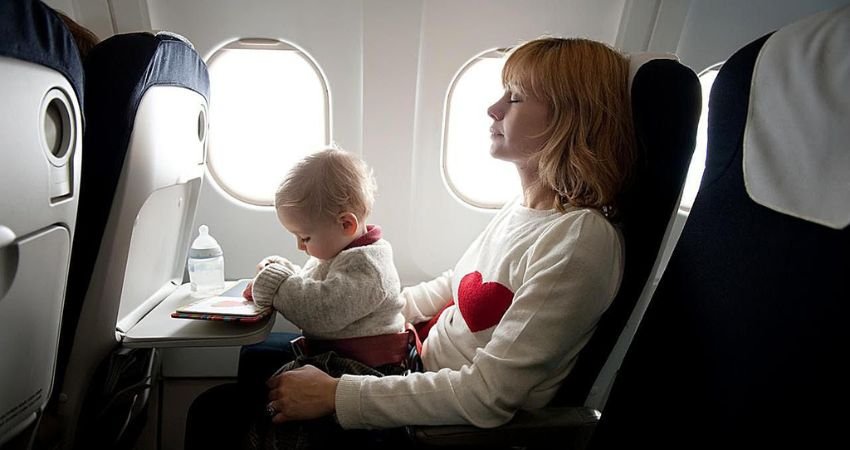
Traveling with a child under two years of age is challenging enough. It requires proper planning and utmost care. You can choose to carry the child on your lap (Infant-in-arms) throughout the journey for free within the US, or you must buy a ticket for your child so they have a reserved seat so they can use an FAA-approved safety seat. The table below will give you more clarity about the topic.
| Travel Options for Infants | Domestic Travel | International Travel |
| Travel in Adults Lap | Any infant can travel freely in an adult’s lap within the US. However, it is imperative to include the baby on your ticket, so you must inform the airline beforehand. | For international travel, you will have to pay 10% of adult fare plus overseas levies. Make the Delta Reservation aware prior to your flight so that they can add the infant to your ticket. |
| Travel in Different Seat | If you want your kid to travel in a separate seat, you will have to buy an additional ticket and carry a child safety seat, which the FAA must approve. | |
Child Safety Seats- Essential things you must know
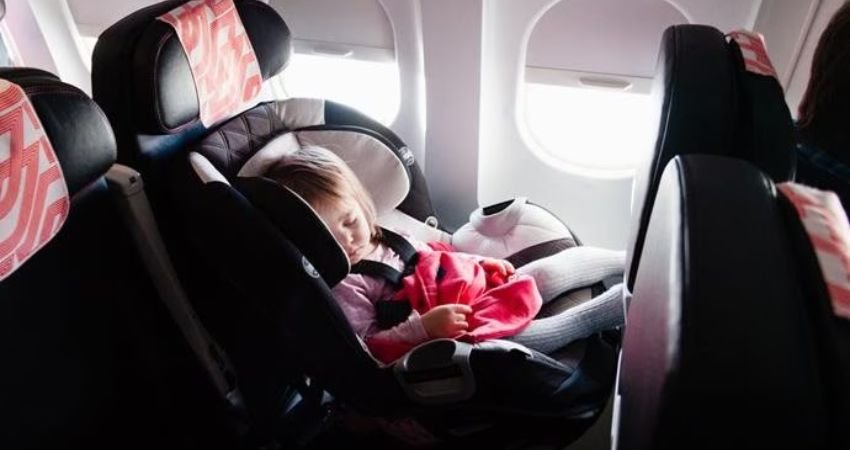
Passengers who want their infants to travel on a separate seat and bring child safety seats along with them must understand that there are certain rules and regulations that they are required to follow.
Where to Place a Child Safety Seat Onboard?
Window seats are generally considered the best for your infant traveling with a child safety seat. You can also choose other seats, but it should not be between other passengers and the aisle and one adult must be sitting next to the infant. Children under the age of two are not permitted to ride in a seat that has an airbag seat belt, according to FAA regulations. The airline suggests not using child safety seats in below areas-
- Seats along the aisle
- Rows of emergency exits
- Bulkhead seats in cases where the safety seat doubles as a stroller and car seat
- Delta Air Lines flatbed seats in Delta One in A330-200 and A330-300 aircraft
Take Off and Touchdown
During the flight takeoff and landing, any adult (18 years or above) can choose to either hold the infant in their lap or seat them in an FAA-approved infant safety harness. Please note that you can not use a booster-style car seat both during flight launch and touchdown.
Obligations for adults
Although Delta Air Lines staff will ensure that your infant travels safely, every adult must follow certain steps to ensure the safe travel of children.
- Verify that the child restraint seat complies with FAA regulations.
- Verify that the child restraint seat is free of visible flaws and operates nicely.
- Make sure that the child does not cross the weight limit.
- Make sure the safety belt on the airplane seat is fastened to the kid restraint.
How to use a Bassinet on board?
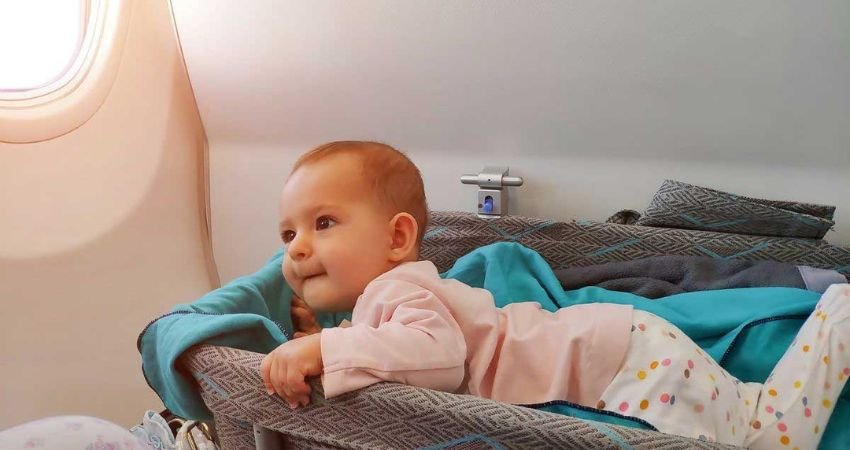
Another fantastic alternative for seating babies up to 20 lbs (9 kg)/ 26 inches (66 cm) in length is a bassinet, which Delta refers to as SkyCots. Passengers in certain seats on equipped aircraft can use it for free on some international trips. Please remember that all infants must be held during takeoff, landing, and any time the seat belt light is illuminated.
A maximum of two SkyCots per aircraft and weight limits mean that while SkyCot requests can be made by contacting Reservations prior to arrival at the airport and speaking with the gate agent at the boarding gate, they cannot be guaranteed.
Delta Air Lines infant baggage policy
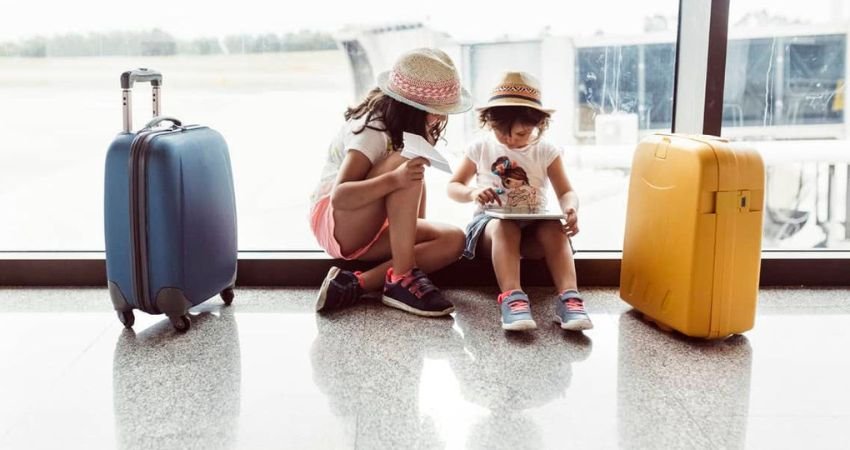
The baggage allowance of an infant depends on whether they are traveling with or without tickets. Below are all the details that you must know before you head to the airport.
Infant traveling without tickets
For babies who are traveling without a ticket (Lap Infant), there is no extra baggage that one can carry. Passengers are required to keep the essentials in their own personal luggage.
Infant traveling with Tickets
For children flying on an international ticket that costs 10% of the adult rate, one checked bag up to 20 pounds (10 kg) with a maximum outer dimension (length + width + height) of 45 inches is permitted, in addition to one checked completely collapsible stroller or pushchair. Free baggage allowance is not available for infants traveling in arms on transatlantic (TATL) or Latin America Basic Economy fares.
| Note- Pack-N-Play portable cribs, playpens, wagons, and other items are included in the allowed amount of checked baggage and should be inspected prior to passing through security. |
Can Pregnant Women travel on Delta?
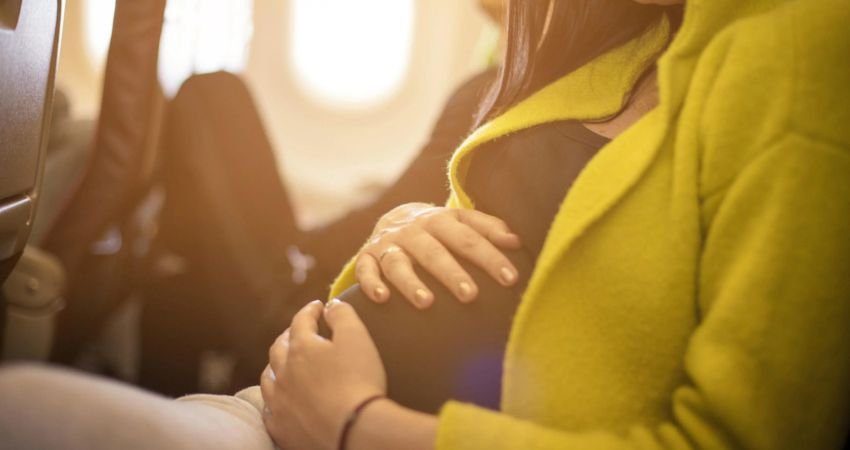
Delta Air Lines does not restrict the travel of pregnant passengers. However, those who are going on an air journey after the eighth month must get a check-up from their doctor to see whether they can continue air travel. Please note that pregnancy does not qualify for an exemption from penalties or ticket-changing fees.
Further Information on Infant Travel
Below are some additional details that will equip you with essential tips regarding Delta Air Lines infant travel policy.
Nursing
Delta supports women’s rights to breastfeed onboard all Delta flights, connections, and facilities. You are allowed to bring a breast pump in your air journey. Additionally, at the airport, there are private lactation rooms or spaces available in many airports for those who prefer them. If you require assistance locating one at an airport, please do not hesitate to ask a Delta associate.
Foreign Travel
Your youngster will need a passport and potentially additional paperwork if your destination demands a passport and/or travel visa. Visit the Special Requirements for Children page of the U.S. Department of State to evaluate the papers required in each country you are going or stopping over in.
Boarding Procedure
Families taking children and newborns on vacation are usually permitted to board early to give themselves enough time to settle in and get situated. Thanks to Delta Air Lines’ boarding procedure, which reduces anxiety and delays, you will have a seamless transition.
Infant Facilities
Delta Airlines strives to offer a superior flying experience for infants by offering complimentary baby meals and diaper-changing facilities in the lavatories on select flights.
Final Thoughts!
The Delta Airlines infant policy has everything needed to provide wonderful travel for your infant. So, make sure you know every detail before you head to the airport. The above manual has every answer, but in case you want more details, you can contact Delta Air Lines.
Last Minute Queries!
Your kid can either sit in a lap or a separate seat with an FAA-approved child safety seat.
It is not necessary for children under the age of two (24 months) to have their own seat. However, you have to let Delta Air Lines know if you plan to travel with a baby on your lap.
When traveling within the United States, infants and children under the age of two can travel for free on an adult’s lap or at a discounted rate when traveling abroad.
Yes. Carry-on luggage for formula, breast milk, toddler drinks, and baby/toddler meals (including puree pouches) in amounts larger than 3.4 ounces or 100 milliliters does not need to fit into a quart-sized suitcase.
No. Kindly make these extra reservations using the adult’s booking. The infant will automatically be checked in at the same time as the accompanying adult.
Experts advise against flying in the first seven days following a baby’s birth. A few medical experts also advise against traveling during the first several months.
All strollers that weigh fifty pounds or more or that are not collapsible are eligible for a free stroller inspection. If you have an FAA-approved car seat for your child, you can use it rear-facing.
For your infant or toddler, you are allowed to pass security and board the aircraft with water, juice, milk, etc. It is not necessary to discard liquids for a baby or toddler prior to going through security.
Under two-year-olds are exempt from the legal requirement to sit in an airline seat; instead, they can travel on their parent’s ticket as “lap infants.” In general, lap infants are free of charge, but if you’re traveling abroad, you might have to pay a portion of the total fare.
The noise level inside an airplane is typically around 100 dB, and it gets significantly louder before takeoff. Your infant may be able to sleep or calm more easily if you use cotton balls, tiny earplugs, or noise-canceling headphones.
Latest Blogs
- Does JetBlue Airlines have first-class? Here is the Answer
- Copa Airlines Check In: Get Boarding Done with Ease!
- Air Canada Boarding Pass- No More Unwanted Surprises!
- Lesser Known Facts About British Airways Premium Economy!
- What happens if you miss the connecting flight?
- Is E-Express an Airline? – Clearing All Doubts!
- All The Insights On How To Book Seats On China Airlines Using Flyblue Points
- Unlock the benefits of Southwest Early Bird Check-in & Maximize Your Boarding Advantages
- Score Free Flights with a United Buddy Pass
- United Airlines MileagePlus Upgrades Eligibility and Types
- Guide to Hawaiian Airlines Baggage Policy and Fees
- What Airlines Fly Tampa To Baltimore?
- TSA Precheck- A Thorough Guide
- Is Same Day Flight Change British Airways Possible? Get Your Answer
- Do Airline Prices Go Down?
- Know Malaysia Airlines Cancellation Policy: Make Informed Decisions
- Pilot Paychecks: How Much Do They Really Make?
- Can you Buy Airline Tickets at the Airport?
- Find Out: What is the Best Day to Buy Airline Ticket?
- Do Airlines Offer Bereavement Fares? Know the Rules & Requirements
- Review: Lufthansa Premium Economy Class
- China Airlines Baggage Policy: Guide for Smooth Travel!
- Which Airline Has the Most Crashes? Read this!
- Atlanta Airport TSA Wait Times
- Emirates Business Class vs First Class Review!
- Southwest Airlines Vacation Packages
- 5 Best Airline to Fly to Paris
- How to get compensation for delayed flight Frontiers?
- Does Delta have a low fare Calendar? Here’s the Answer
- Spirit Airlines Personal Item Size- Know Before You Fly!
Latest Pages
- Norwegian Air Madrid Office In Spain
- Norwegian Air Helsinki Office In Finland
- Norwegian Air Tallinn Office In Estonia
- Norwegian Air Billund Office In Denmark
- Norwegian Air Aalborg Office In Denmark
- Norwegian Air Prague Office In Czech Republic
- Norwegian Air Vienna Office In Austria
- Norwegian Air Tirana Office In Albania
- Tara Air Kathmandu Office In Nepal
- RwandAir Kigali Office In Rwanda

Leave a Reply